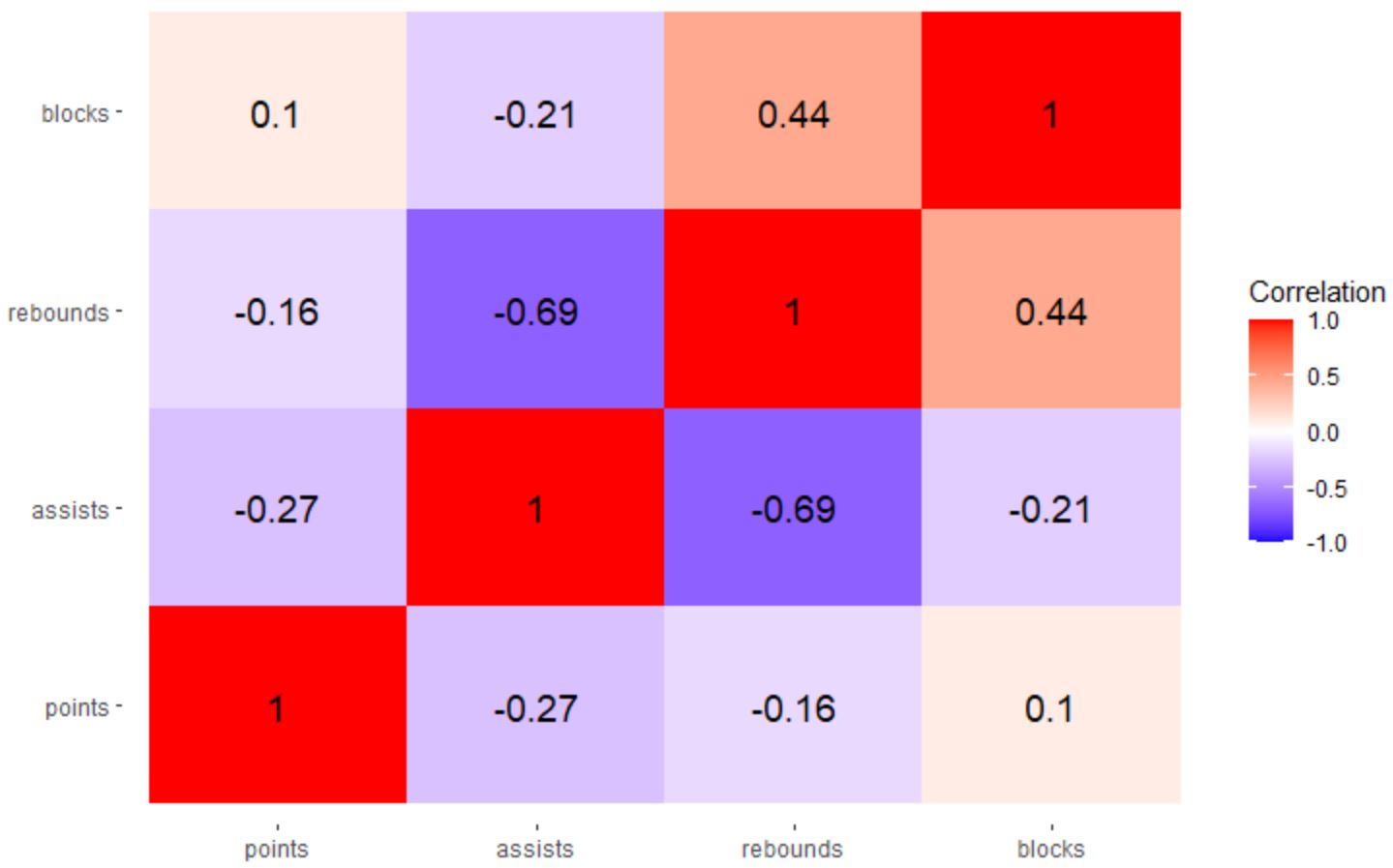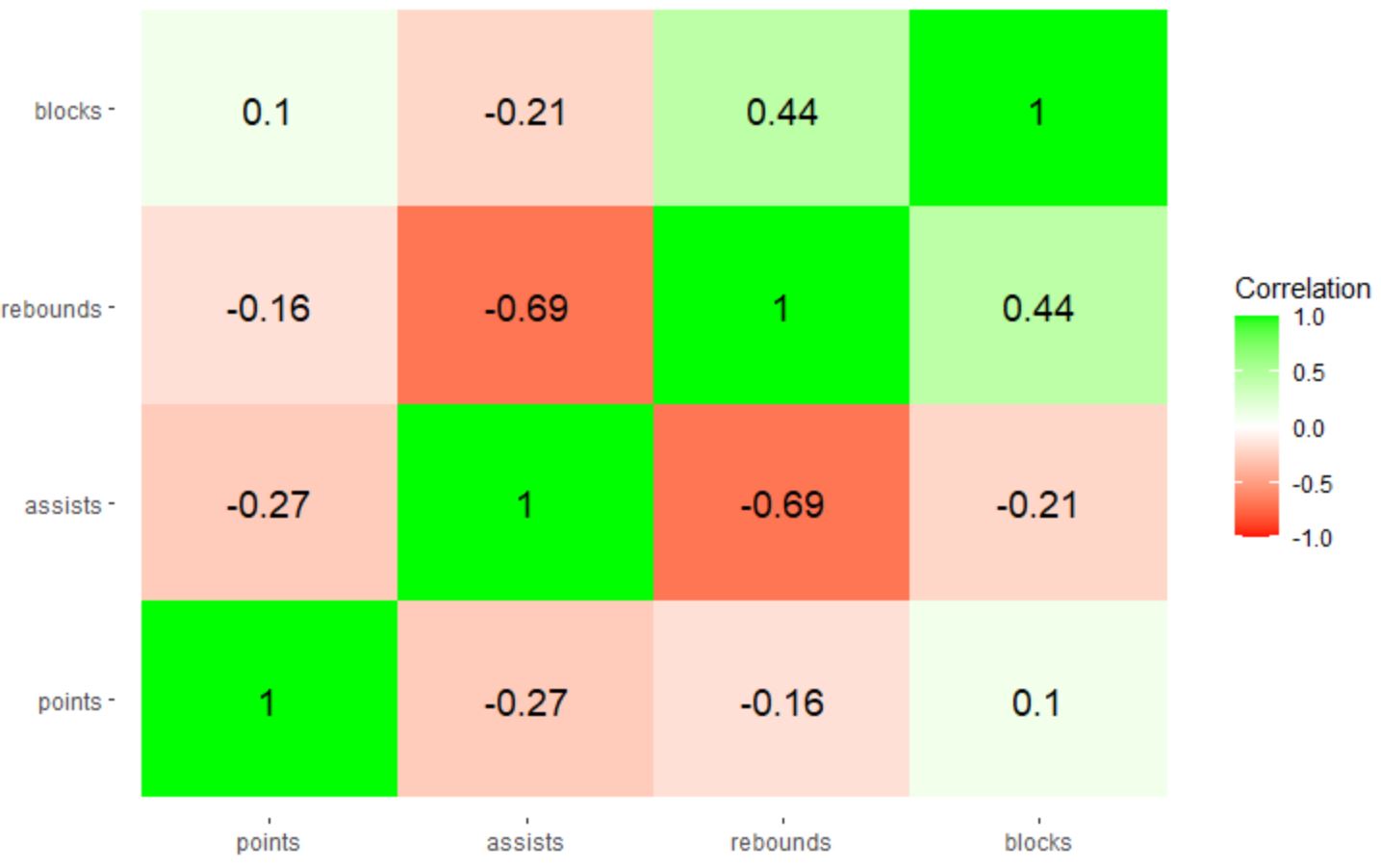R で相関ヒートマップを作成する方法 (例付き)
次の基本構文を使用して、R で相関ヒート マップを作成できます。
#calculate correlation between each pairwise combination of variables cor_df <- round(cor(df), 2) #melt the data frame melted_cormat <- melt(cor_df) #create correlation heatmap ggplot(data = melted_cormat, aes(x=Var1, y=Var2, fill=value)) + geom_tile() + geom_text(aes(Var2, Var1, label = value), size = 5 ) + scale_fill_gradient2(low = " blue ", high = " red ", limit = c(-1,1), name=" Correlation ") + theme(axis. title . x = element_blank(), axis. title . y = element_blank(), panel. background = element_blank())
次の例は、この構文を実際に使用する方法を示しています。
例: R で相関ヒートマップを作成する
R に、8 人の異なるバスケットボール選手のさまざまな統計を示す次のデータ フレームがあるとします。
#create data frame
df <- data. frame (points=c(22, 25, 30, 16, 14, 18, 29, 22),
assists=c(4, 4, 5, 7, 8, 6, 7, 12),
rebounds=c(10, 7, 7, 6, 8, 5, 4, 3),
blocks=c(12, 4, 4, 6, 5, 3, 8, 5))
#view data frame
df
points assists rebounds blocks
1 22 4 10 12
2 25 4 7 4
3 30 5 7 4
4 16 7 6 6
5 14 8 8 5
6 18 6 5 3
7 29 7 4 8
8 22 12 3 5
相関ヒートマップを作成して、データ フレーム内の変数のペアごとの組み合わせ間の 相関係数を視覚化するとします。
相関ヒートマップを作成する前に、まずcor()を使用して各変数間の相関係数を計算し、次にパッケージのMelt()関数reshape2を使用して結果を使用可能な形式に変換する必要があります。
library (reshape2) #calculate correlation coefficients, rounded to 2 decimal places cor_df <- round(cor(df), 2) #melt the data frame melted_cor <- melt(cor_df) #view head of melted data frame head(melted_cor) Var1 Var2 value 1 points points 1.00 2 assist points -0.27 3 rebound points -0.16 4 block points 0.10 5 assist points -0.27 6 assists assists 1.00
次に、 ggplot2パッケージのgeom_tile()関数を使用して、相関ヒートマップを作成できます。
library (ggplot2) #create correlation heatmap ggplot(data = melted_cor, aes(x=Var1, y=Var2, fill=value)) + geom_tile() + geom_text(aes(Var2, Var1, label = value), size = 5 ) + scale_fill_gradient2(low = " blue ", high = " red ", limit = c(-1,1), name=" Correlation ") + theme(axis. title . x = element_blank(), axis. title . y = element_blank(), panel. background = element_blank())

その結果、変数のペアごとの組み合わせ間の相関係数を視覚化できる相関ヒートマップが得られます。
この特定のヒート マップでは、相関係数は次の色を帯びます。
- -1に近い場合は青
- 0に近い場合は白
- 1に近い場合は赤
scale_fill_gradient2()関数のlow引数とhigh引数には、任意の色を自由に使用できます。
たとえば、低い値には「赤」を使用し、高い値には「緑」を使用できます。
library (ggplot2) #create correlation heatmap ggplot(data = melted_cor, aes(x=Var1, y=Var2, fill=value)) + geom_tile() + geom_text(aes(Var2, Var1, label = value), size = 5 ) + scale_fill_gradient2(low = " red ", high = " green ", limit = c(-1,1), name=" Correlation ") + theme(axis. title . x = element_blank(), axis. title . y = element_blank(), panel. background = element_blank())

注: 相関ヒート マップの正確な色をさらに詳細に制御したい場合は、使用する 16 進数のカラー コードを指定することもできます。
追加リソース
次のチュートリアルでは、ggplot2 で他の一般的なタスクを実行する方法を説明します。
ggplot2 で軸ラベルを回転する方法
ggplot2で軸ブレークを設定する方法
ggplot2 で軸の制限を設定する方法
ggplot2で凡例ラベルを変更する方法